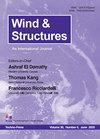级联h桥多电平变换器在开放式绕组风能转换系统中的应用
IF 1.9
4区 工程技术
Q3 CONSTRUCTION & BUILDING TECHNOLOGY
引用次数: 0
摘要
随着全球可再生能源的不断扩张,风能是其中的佼佼者。随着技术的进步,风力涡轮机项目的功率大大增加,达到更高的功率,主要用于海上装置。其中一个主要的挑战是功率转换器,更具体地说,是半导体元件,它们具有有限的电压和电流能力。因此,多电平变换器的概念出现,增加电压水平,从而承载更高的功率水平。除了多电平变换器的应用之外,还可以通过与发电机的开放式绕组(OEW)连接来增加电压和功率水平。在这种情况下,本研究研究了一个多电平变流器(三电平串联h桥背靠背)驱动一个鼠笼感应电机的开放式绕组结构,连接到风能转换系统(WECS)。利用PLECS软件对一个1.67 MW的WECS进行了动态仿真,对系统进行了分析,包括主要系统组件的建模:发电机、电源变流器、系统控制、滤波器和并网。结果表明,使用OEW连接可以实现输出电压的5电平特性。此外,在注入电网的电流中,在机器电流中实现了低谐波含量。此外,还可以验证转换器之间的功率分布,表明可以将功率较小的转换器组合在一起以达到更高的WECS功率。本文章由计算机程序翻译,如有差异,请以英文原文为准。
Cascaded H-Bridge Multilevel Converter Applied to a Wind Energy Conversion System with Open-End Winding
With the growing expansion of renewable sources around the world, wind energy is among those that stand out. With the advances of technology, wind turbine projects have considerably increased their power, reaching higher power, mainly for offshore installations. One of the main challenges is the power converters, more specifically the semiconductor components, which have limited voltage and current capabilities. Thus, the concept of multilevel converters emerged, increasing the voltage levels and thus carrying higher power levels. In addition to the application of multilevel converters, it is possible to increase the voltage and power levels employing an open-end winding (OEW) connection to the generator. In this context, the present work investigated the application of a multilevel converter (three-level cascaded H-bridge back-to-back) driving a squirrel-cage induction machine in an open-end winding configuration, connected to a wind energy conversion system (WECS). The analysis of the proposed system was developed through dynamic simulation of a 1.67 MW WECS, using PLECS software, including the modeling of the main system components: generator, power converters, system control, filter, and grid connection. The results show that the objective of obtaining a 5-level behavior in the output voltage is achieved by using the OEW connection. Furthermore, a low harmonic content is achieved in the machine current as in the current injected into the grid. In addition, it is possible to verify the power distribution between the converters, demonstrating that converters with smaller power can be combined to reach higher WECS power.
求助全文
通过发布文献求助,成功后即可免费获取论文全文。
去求助
来源期刊

Wind and Structures
工程技术-工程:土木
CiteScore
2.70
自引率
18.80%
发文量
0
审稿时长
>12 weeks
期刊介绍:
The WIND AND STRUCTURES, An International Journal, aims at: - Major publication channel for research in the general area of wind and structural engineering, - Wider distribution at more affordable subscription rates; - Faster reviewing and publication for manuscripts submitted.
The main theme of the Journal is the wind effects on structures. Areas covered by the journal include:
Wind loads and structural response,
Bluff-body aerodynamics,
Computational method,
Wind tunnel modeling,
Local wind environment,
Codes and regulations,
Wind effects on large scale structures.
 求助内容:
求助内容: 应助结果提醒方式:
应助结果提醒方式:


